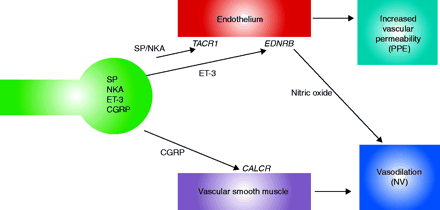
- Institution: Stanford Univ Med Ctr Lane Med Lib/Periodical Dept/Rm L109
- Sign In as Member / Individual
NEUROGENIC INFLAMMATION AND MIGRAINE: IMPLICATIONS FOR THE THERAPEUTICS

Molecular pathways of neurogenic inflammation. Neurogenic inflammation consists of two physiological arms, namely, plasma protein extravasation (PPE) and neurogenic vasodilatation (NV). The release of neuropeptides from trigeminal neurons (green) can be stimulated or inhibited by distinct agents. Both the endothelium and vascular smooth muscle can contribute, differentially, to neurogenic inflammation. The endothelium, for example, can promote vasodilatation through the use of NO as a messenger, whereas vascular smooth muscle may contribute directly to vasodilatation. (SP, substance P; NKA, neurokinin A; ET-3, endothelin-3; CGRP, calcitonin gene–related peptide; TACR1, tachykinin receptor 1; EDNRB, endothelin receptor type B; CALCR, calcitonin receptor.)


